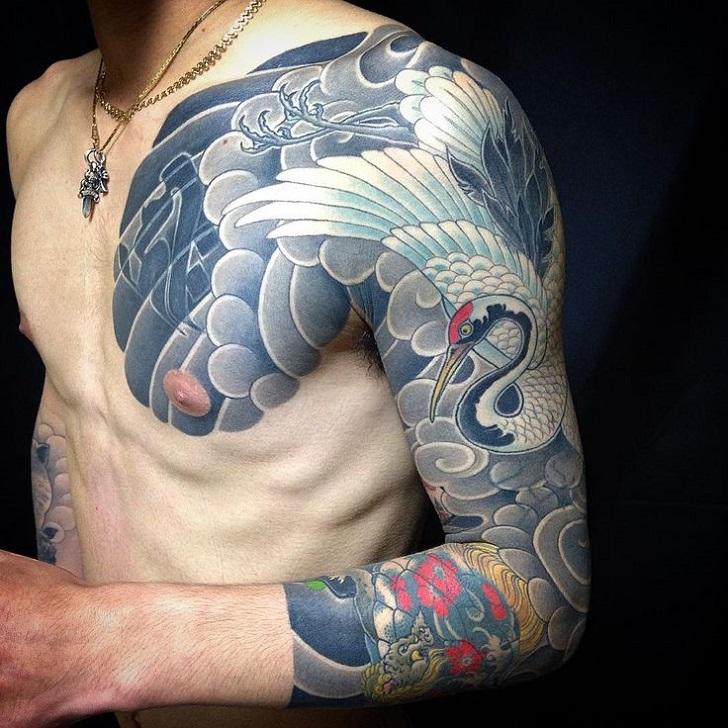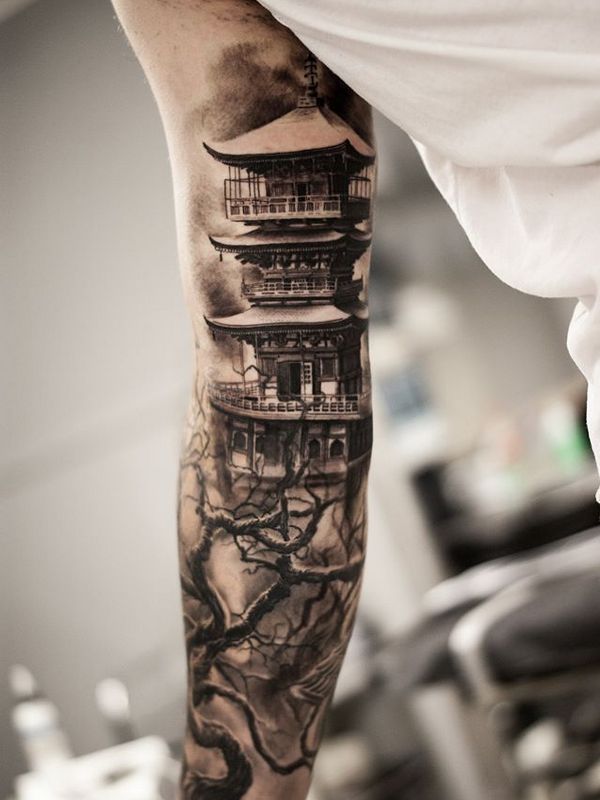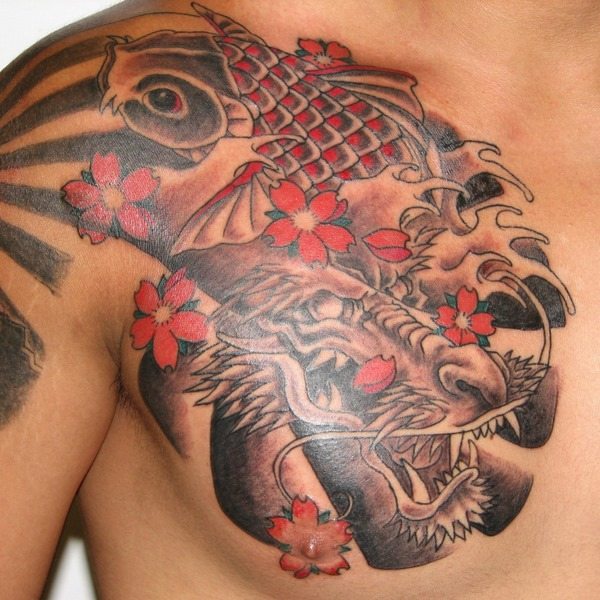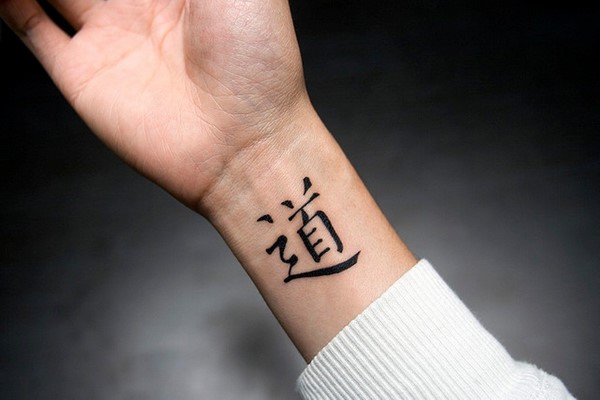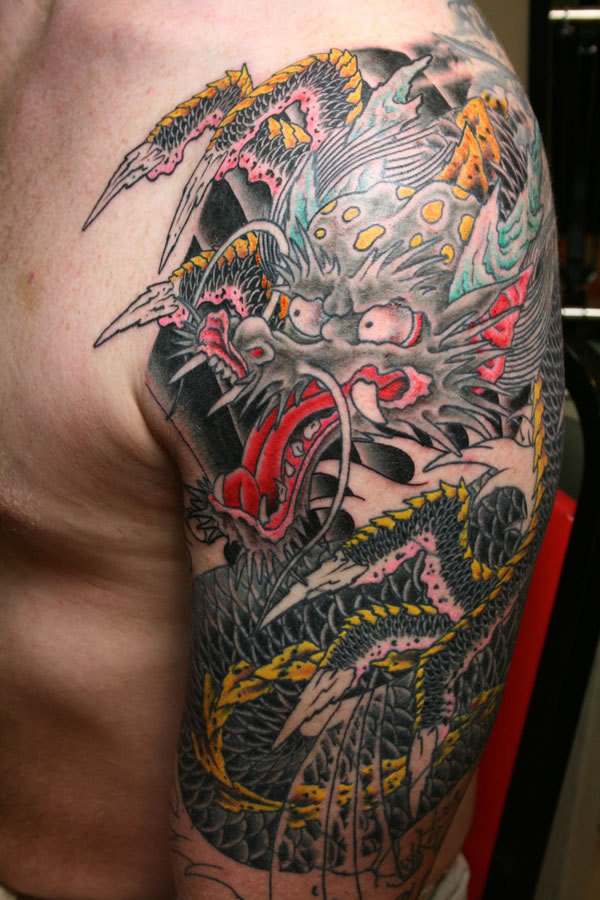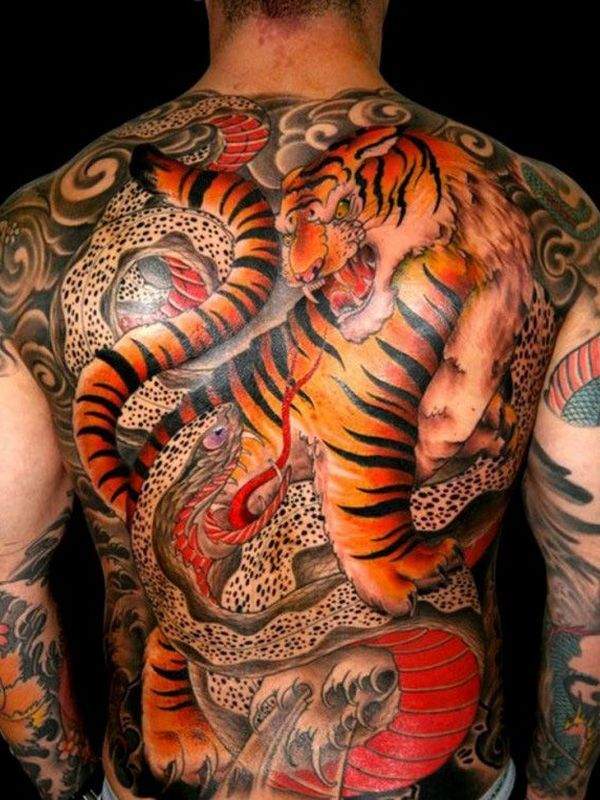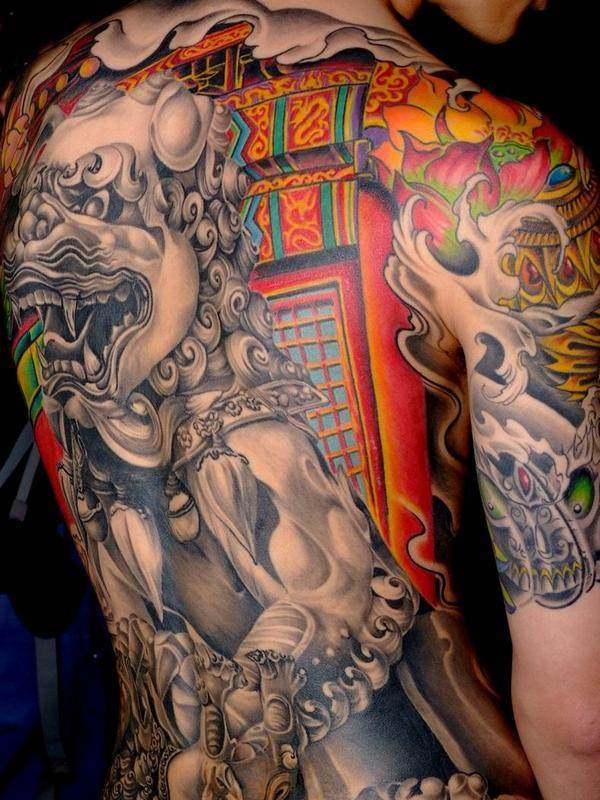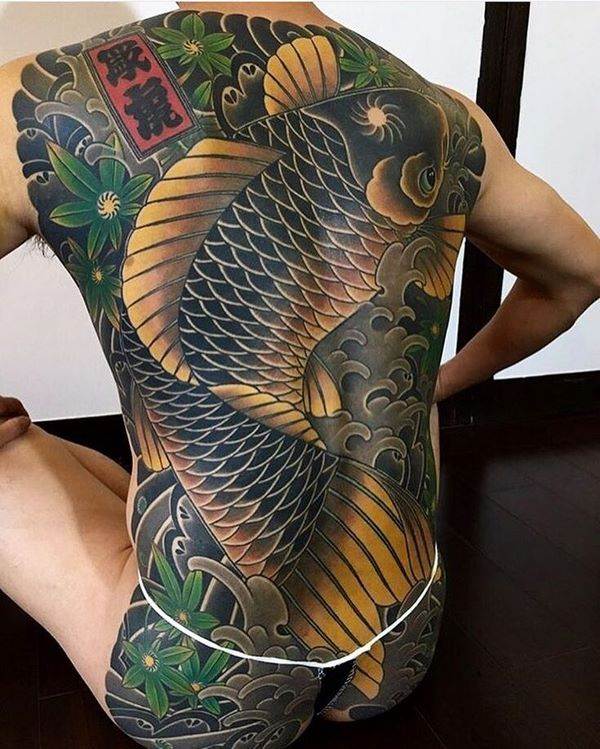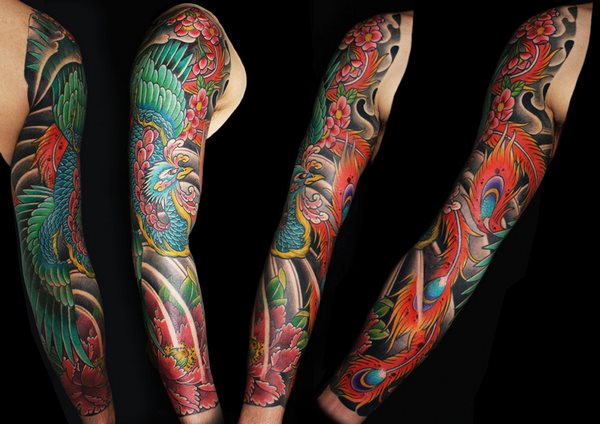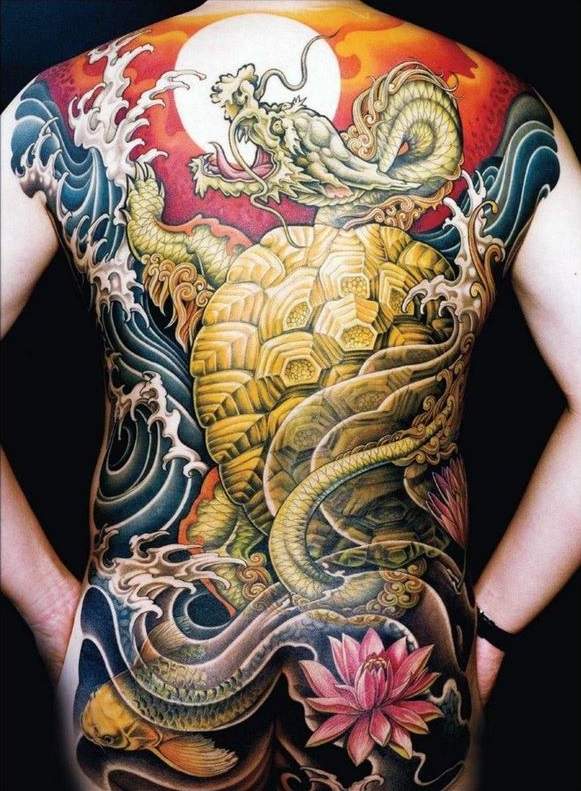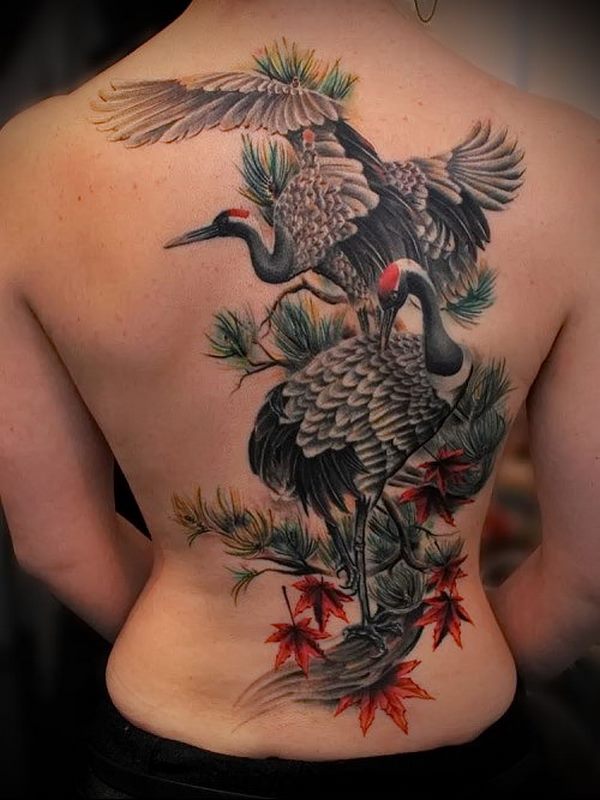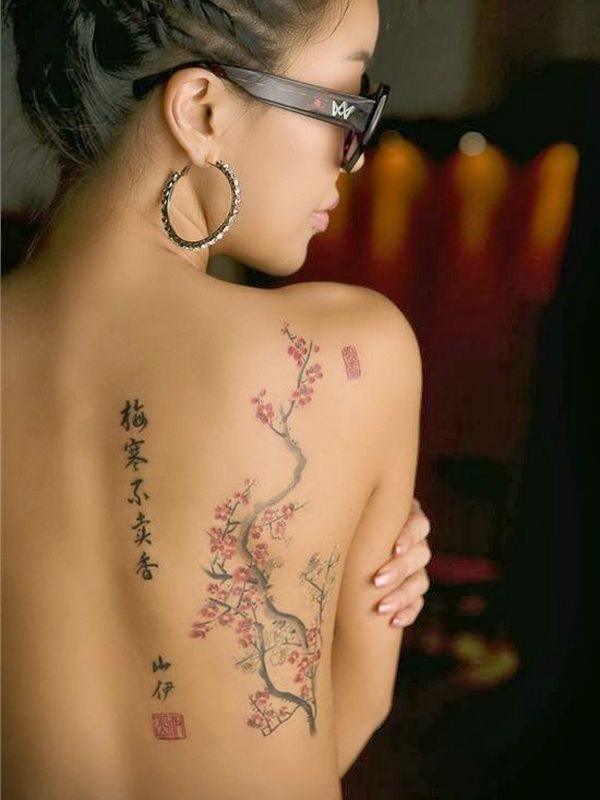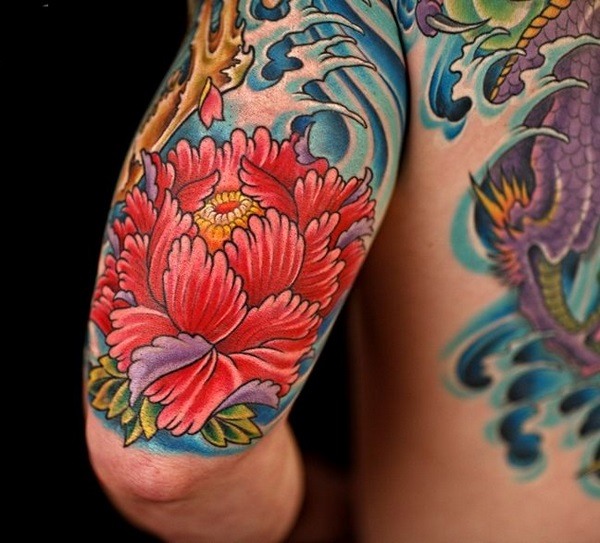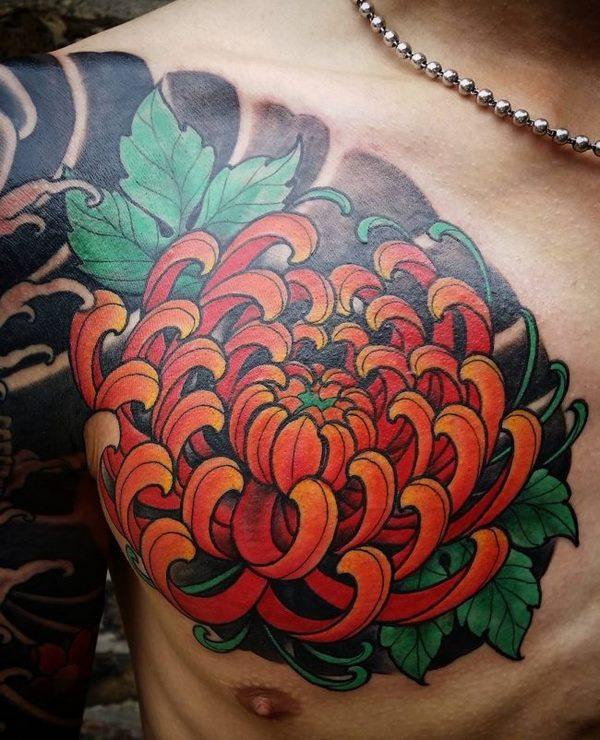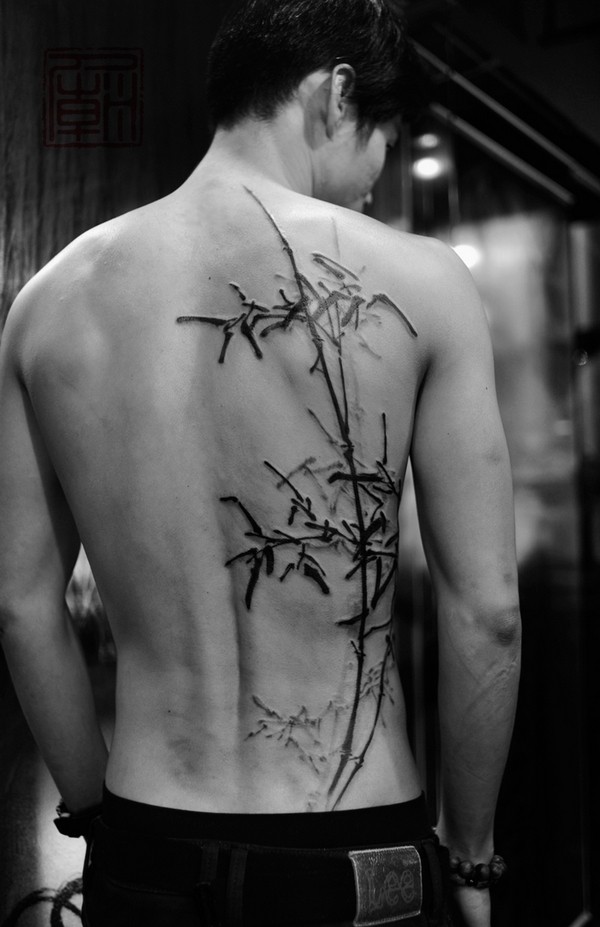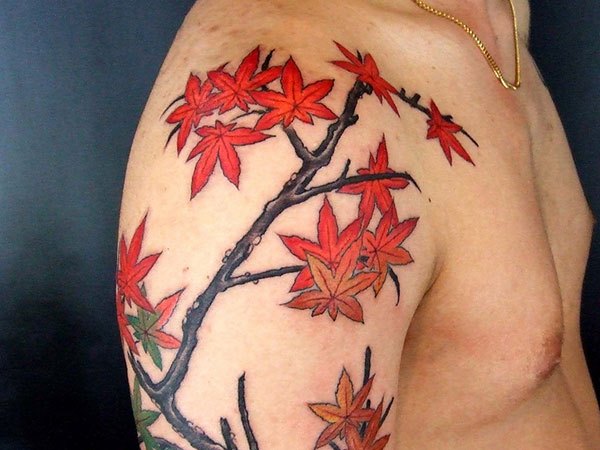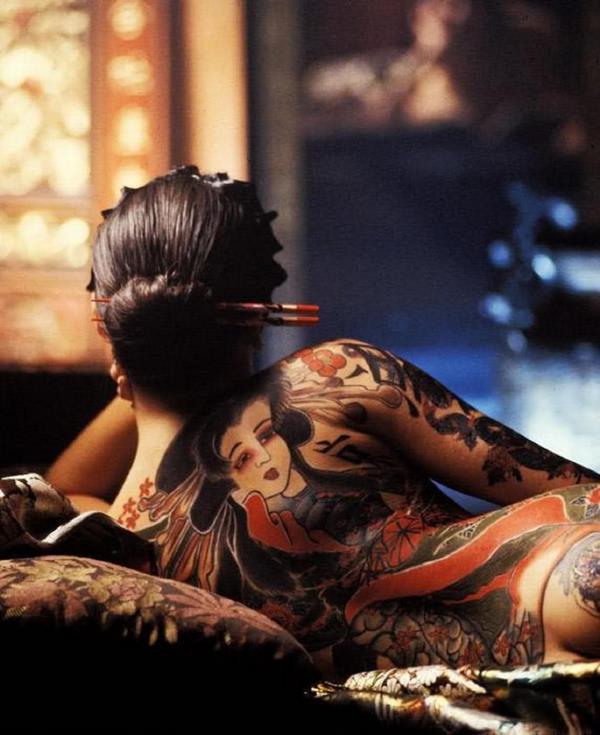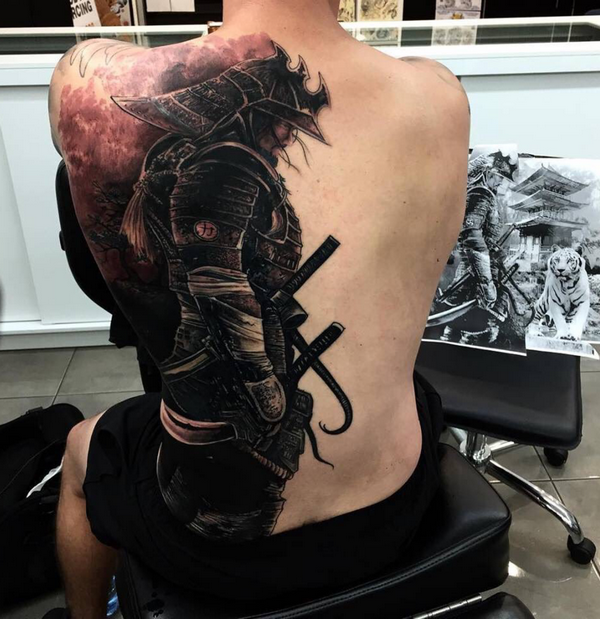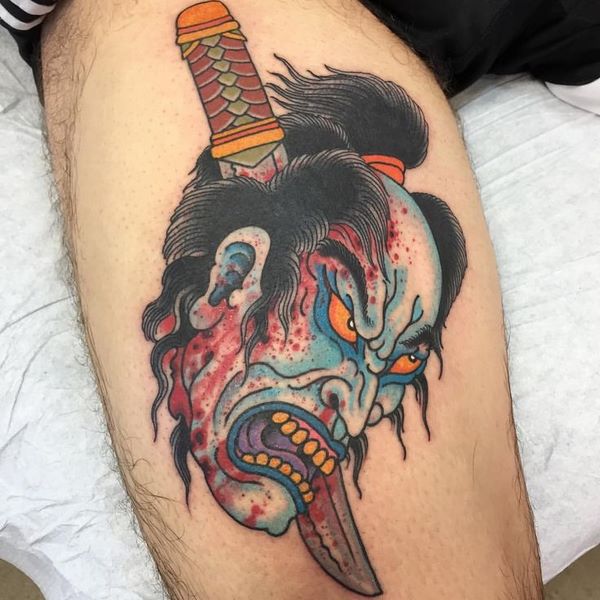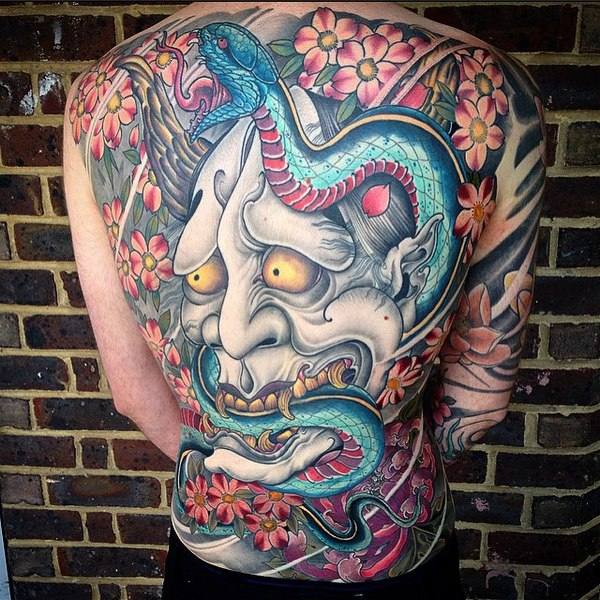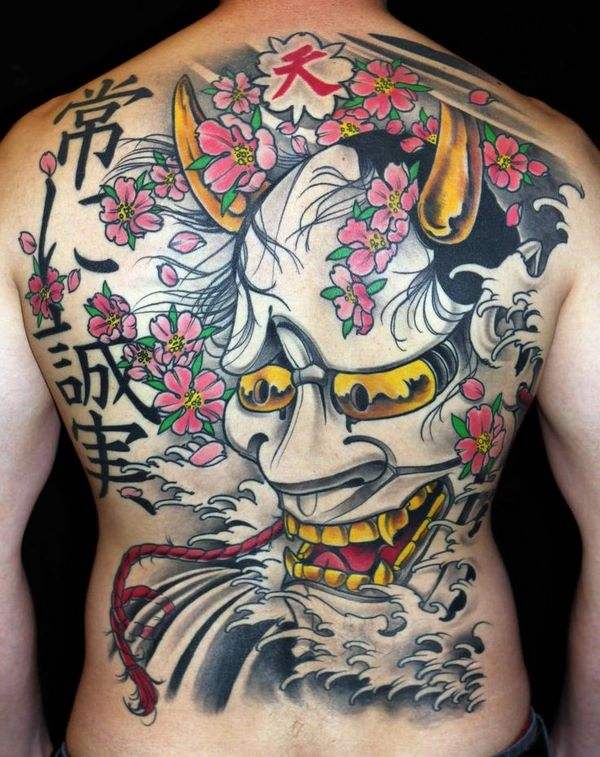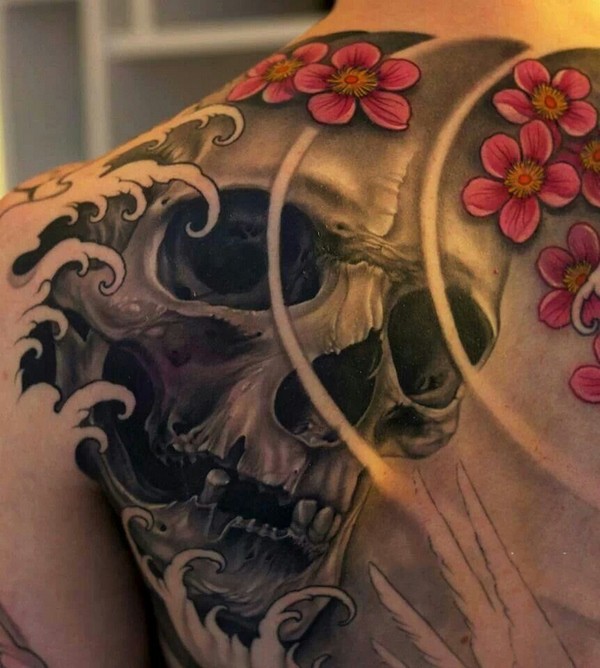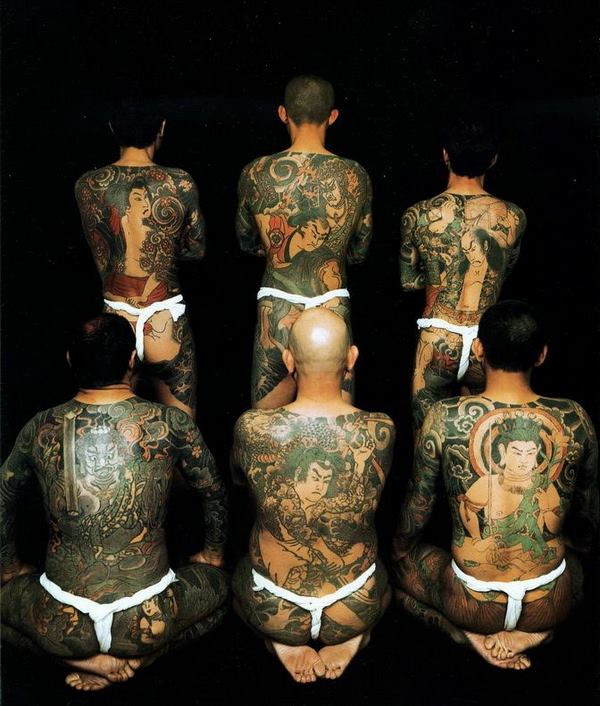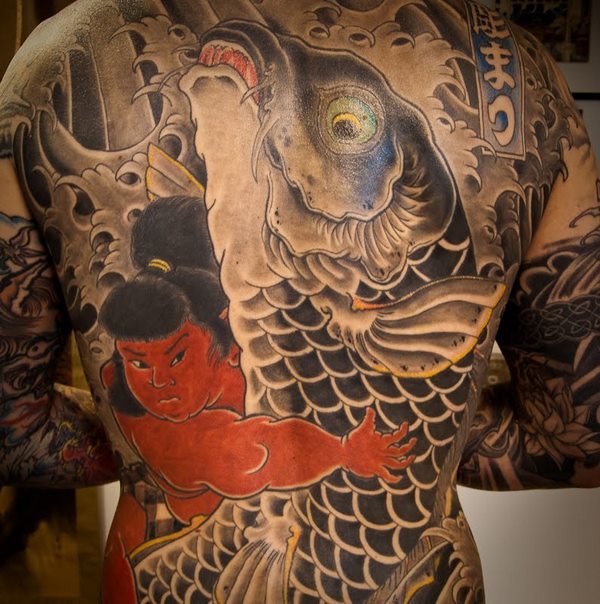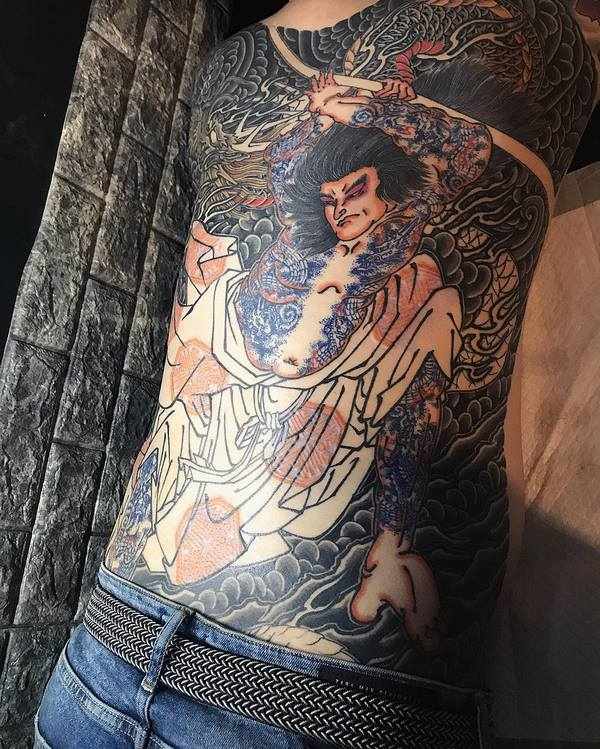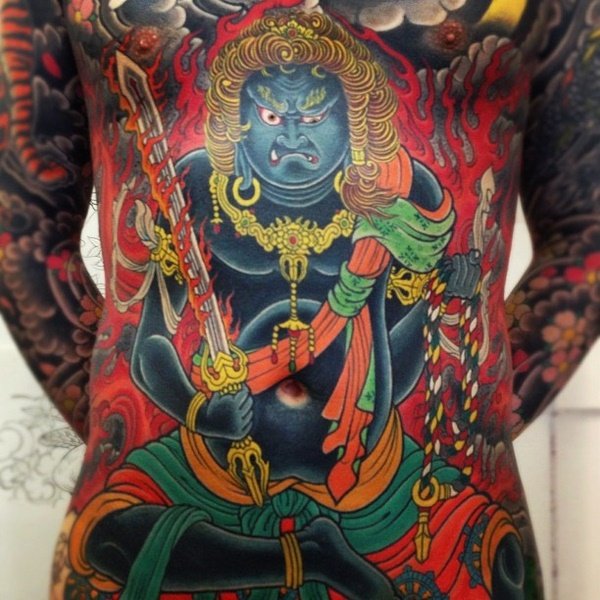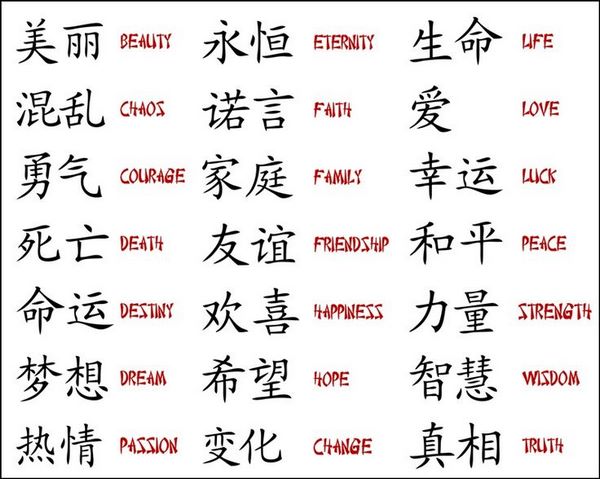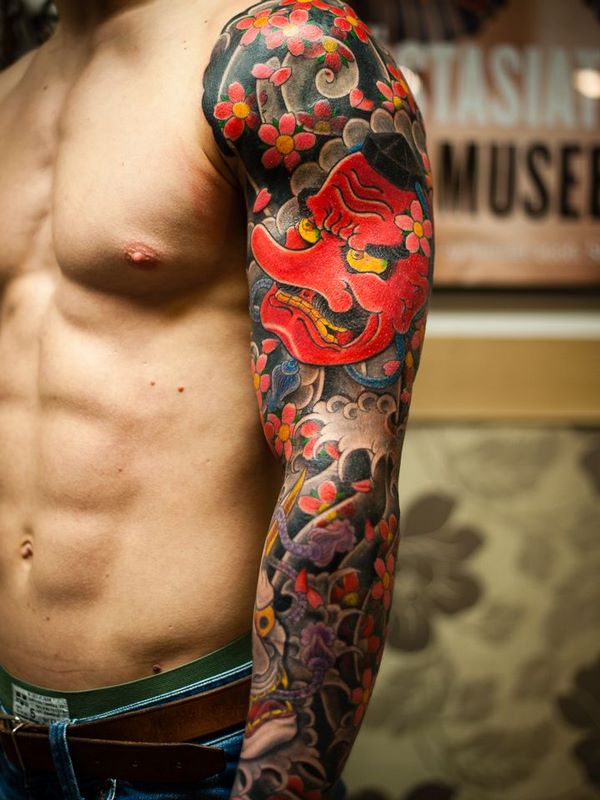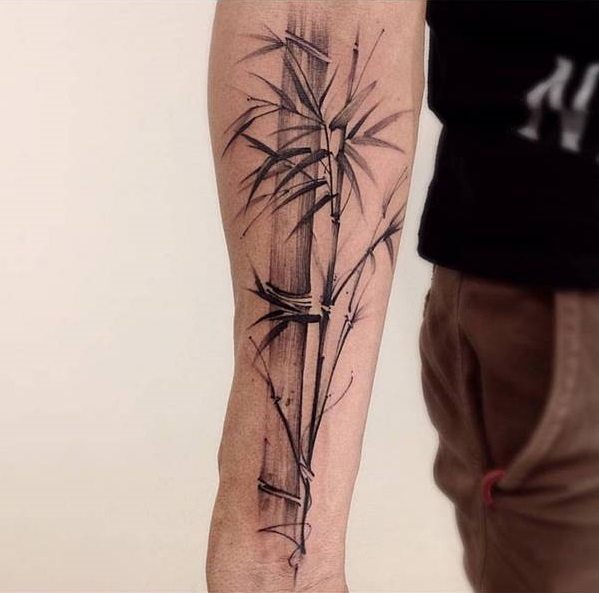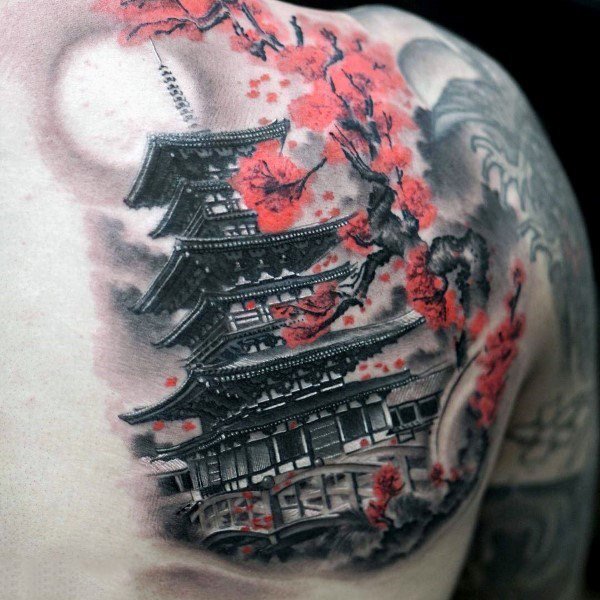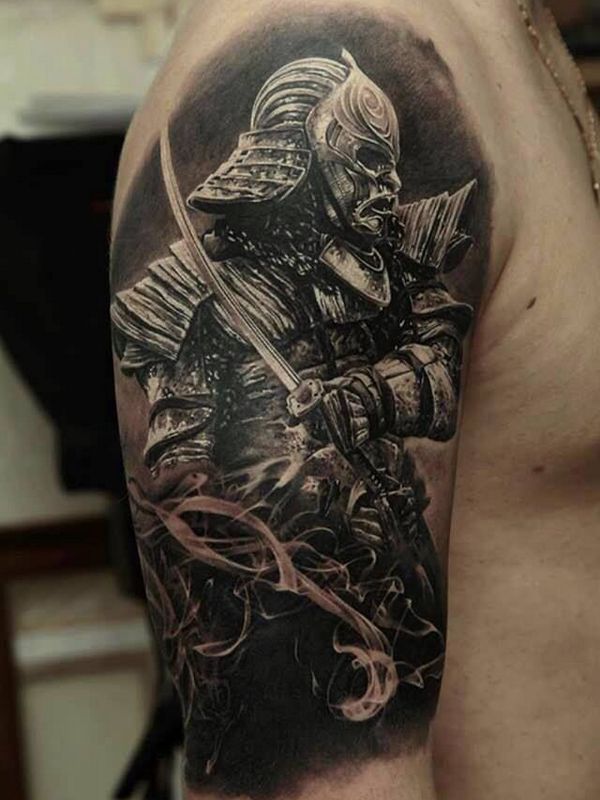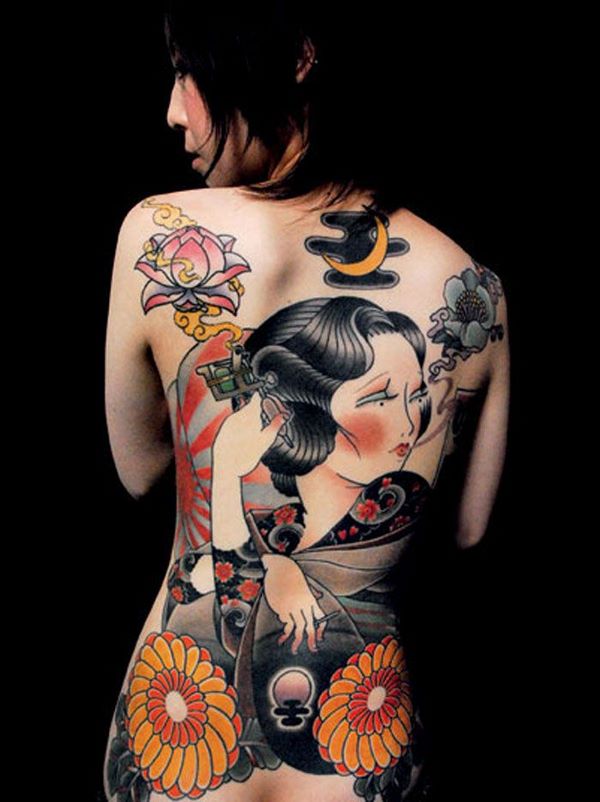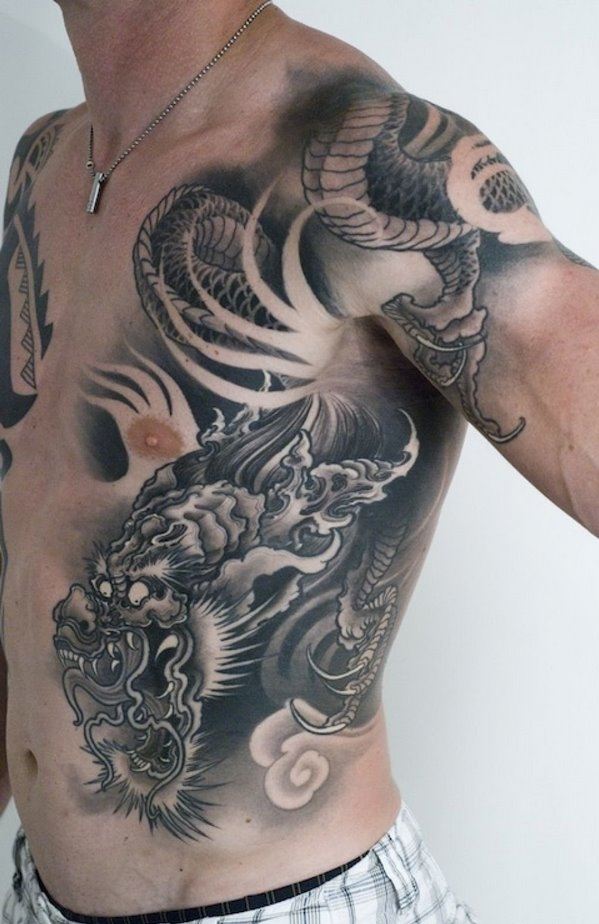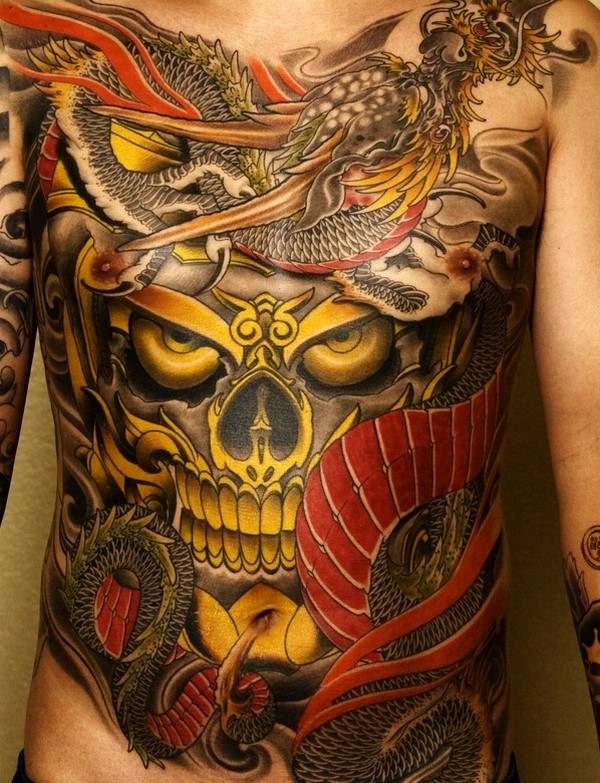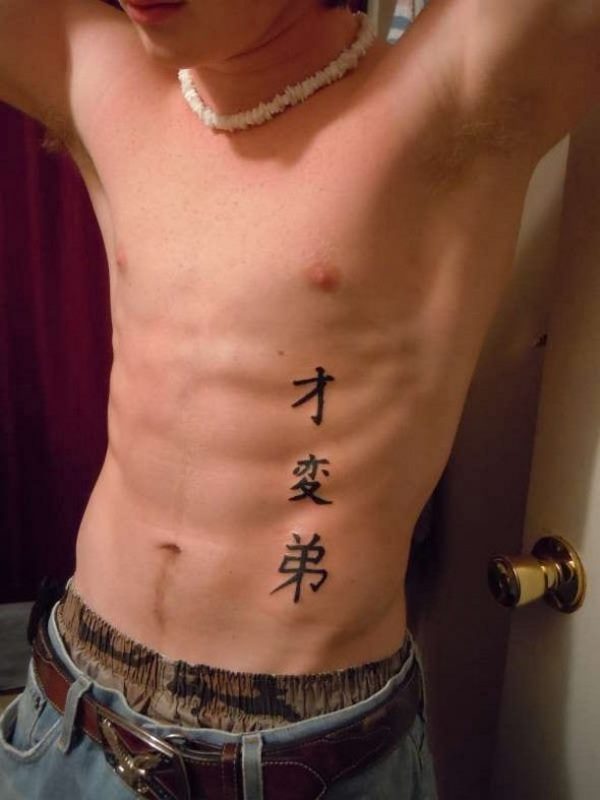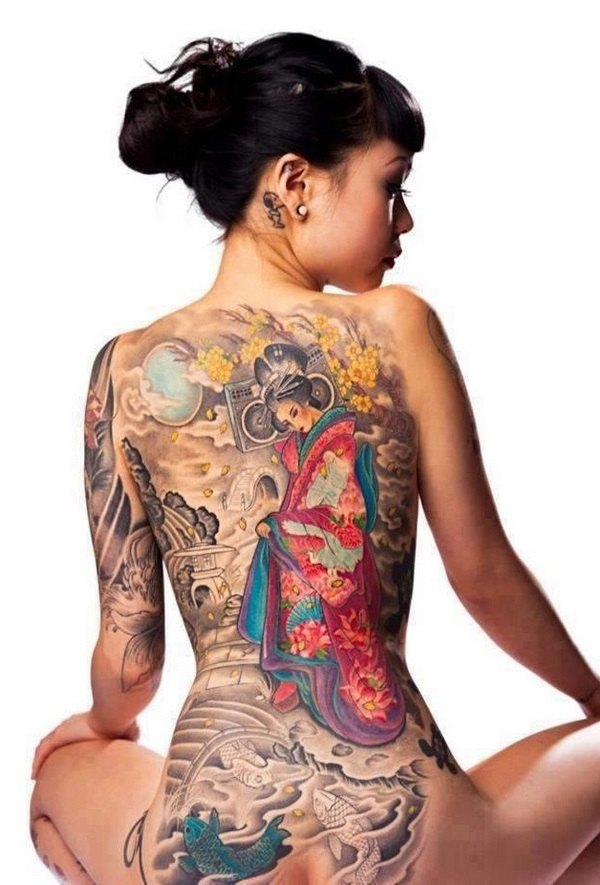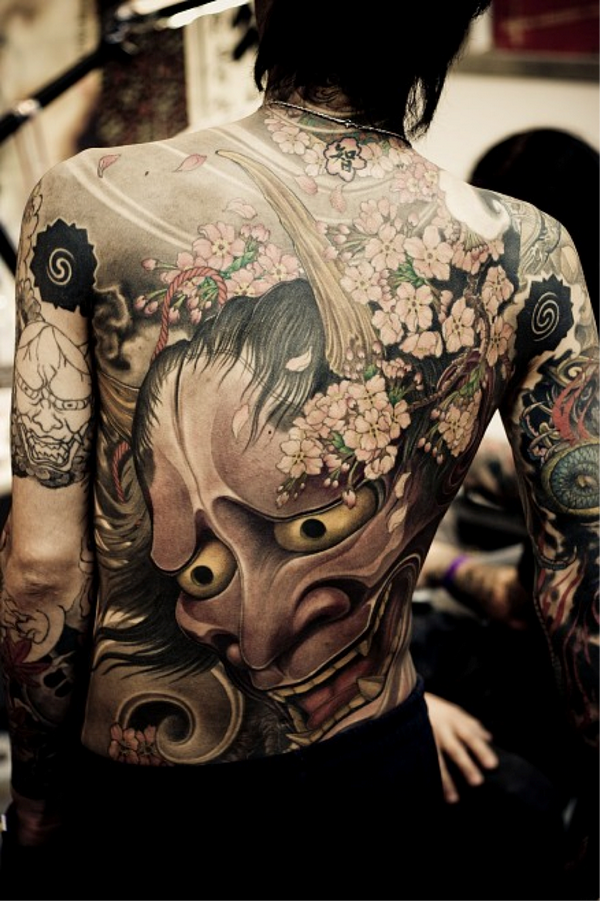Japanese tattoos vary in style, symbols and appeared hundreds of years ago. Irezumi is the official term for ancient pigment modifications. They have become famous for the huge scale compositions. In these tattoos several elements and images are combined and there are no empty areas between them – all the area is filled with ornaments.
In the past, tattoos were banned in Japan, with one unusual exception. Tattoos were allowed only to firefighters, so they decorated their body with very intricate drawings. It was believed that if the firefighter died, he could be identified by the drawings. Tattoos were forbidden by law for anyone else. Why were tattoos forbidden? Because society had a clear division into classes and if everyone had body drawings it would have led to a mixing of classes. Because of these prohibitions, Japanese tattoos were applied to parts of the body that could be covered – legs, chest, hands and with time they became a distinctive feature of actors and geishas. Former prisoners, too, decorated themselves with large-scale ornaments and patterns.
This changed during the 17th century when tattoos were allowed to ordinary people and became popular among Yakuza members. Nevertheless, even nowadays, wearing tattoos in Japan is not encouraged. In traditional Japanese tattoo culture there are many images. For example, lions, dragons and demons are combined with flowers, indicating a balance of strength and beauty. Many modern Japanese tattoo masters still use the manual method of painting the body and do not use electric devices.
Types of Japanese tattoos and traditional images
In Japan the most beautiful thing is the one that is not obvious, not exposed to the eye. This is a part of Japanese traditional culture, and without it the Japanese would lose their sense of beauty. This principle applies to Japanese tattoos as well. The traditional images are called ukiyo-e – “images of the floating world”. These are wood-block prints produced by ukiyo-e artists.
Usually, tattoo designs are asymmetric and the contour is made with very thin lines. Moving images are also a Japanese innovation – the tattoos are applied to muscle areas. As we mentioned, Japanese style tattoos are large sized, quite complex and due to that they are applied for more than one day, so if you consider such a tattoo, you need to be prepared that it will take several visits to the studio. The composition of a Japanese tattoo is very important. Each component of the whole image must contain a sense and characterize the person. The images which are used represent the personal beliefs of the man and are blended in a way to tell a story.
Japanese style tattoos are instantly recognizable. They feature intricate details, intriguing images from mythology and folklore and the compositions follow strict rules – for example, a Buddha figure cannot be placed below the waist as this is considered disrespectful, clouds are placed above the waist as they represent the sky while waves should be below the waistline, combining flowers and animals also has its logic – a koi fish swimming upstream is paired it with maples or chrysanthemums since they swim upstream only during the fall.
There are three major groups of images which are typical for the Japanese style tattoos – animals, flowers and figures. The group of animals features mythological monsters like dragons as well as tigers, lions, birds, koi fish and snake. The most popular image in the group of flowers is, of course the sakura (cherry blossoms) followed by Chrysanthemums, lotus and peonies. The group of figures includes images from the folklore – Tengu (ghosts) and Oni (demons) as well as Suikoden (geisha, samurai), Buddha and Buddhist deities.
Japanese tattoos meaning – understanding the symbols
It is essential to understand the meaning of any image but for Japanese tattoos, it is crucial. Otherwise the final result could be catastrophic. Below we shall look at the meaning of the most popular images and their symbolism.
Japanese kanji tattoos are among the most popular choices for both men and women. This kind of body painting has an unusual beauty and masterfully applied traditional calligraphic letters can be a small tattoo or combined with other traditional symbols.
The most popular and iconic image in Japanese style tattoos is a dragon. Dragons are mythological creatures and they symbolize good forces that are always ready to protect human beings. Dragons also represent strength, good fortune, courage and wisdom. Very often dragons are depicted with parts of the bodies of other animals – ears of a bull or a snake body. As these magical creatures are associated with air as well as water, dragons are often illustrated with waves. Dragons can be tattooed in different colors – black, red, green, white, blue, or yellow- and each of the colors stands for a dragon from a different area or sea.
Tigers are not found in Japan but this did not prevent tattoos with tigers becoming so popular. Tigers are depicted in an aggressive posture, showing their teeth. Generally, these animals symbolize strength, power, and courage. It is believed that tigers can drive away demons, diseases and prevent misfortune. The image of a tiger is often combined with bamboo stalks, wind, clouds and can be paired with dragon or snake. When paired with a dragon, tigers are usually fighting with it which symbolizes the duality of all that exists, where the dragon corresponds to the male “yang”, and the tiger – to the female “yin”. The fight does not bring victory to either the dragon or the tiger, and legends say that this duel ends in friendship and consent.
Lion (fu-dog) traditionally represents power, strength, and protection. Lions are combined with peonies and are often depicted with a round jewel under their paw or in their mouth.
Koi fish is considered to be the king of freshwater fish. It is one of the iconic symbols in Japanese tattoos linked with water and most often Koi are depicted swimming upstream which represents the struggling to overcome obstacles. Legends tell that if a koi fish swims is able to swim the Yellow River upstream, it turns in to a dragon which is a reward for their courage and strength and the successful overcoming of the challenge. When Koi fish is depicted swimming in the downstream direction, it symbolizes obstacles and struggle which are not yet overcome. Generally, the meaning of Koi fish is luck, success, hard work, and determination. The image can be seen in many attractive tattoos and is popular among both men and women.
The phoenix (hou-ou in Japanese) is a legendary bird, a mythical creature that can regenerate again and again from the ashes. It is a symbol of transformation, triumph over obstacles, loyalty, rebirth, and renewal. A phoenix can symbolize eternal love and the hope of a rebirth after death. Usually, the bird is tattooed with brightly colored plumage and a long flowing tail and since it is associated with fire it is often used as an opposition to the dragon (fire and water). The phoenix, as well as the chrysanthemum flower, is a symbol of the Japanese emperor.
A turtle is a common image in Eastern mythology, a symbol of wealth, wisdom, protection, luck and longevity, since it is believed that it is able to live forever, unless it is killed. In China and in Japan, a turtle with a long train of seaweed or algae is called the Japanese “Minogame” and it is believed that the turtle has supernatural abilities, the main one being the ability to foresee and predict the future. Turtles, or minogame, are usually depicted in water, sometimes with other water-related creatures. Coming from mythology is the image of the turtle- dragon which is a symbol of the harmony of the universe. According to the legend, a turtle gave its body to the spirit of a deceased dragon, in order to strengthen the protective abilities so necessary for the emperor and the country. The resulting monster combined the courage and ambition of a dragon, and the wisdom of a turtle. It is believed that this mythological animal promotes favorable changes in a person’s career.
Cranes have always enjoyed special honor and in Japan they are considered as a national treasure and a sacred bird. The Japanese crane became the hero of many legends and fairy tales. People believed that cranes are able to turn into people, and, often taking the shape of wandering monks, do good deeds. Cranes are a symbol of longevity and fortune.
Japanese flower tattoos feature a variety of traditional symbols. We shall look at the meaning of the most popular ones – the cherry blossoms, peonies, chrysanthemum, lotus, maple leaves.
Sakura or cherry blossom is a five petal pink or white flower. This is one of the most famous symbols of Japan and is very popular as a tattoo. Cherry trees blooms in early spring, and very quickly lose the petals of their flowers. The short life of these tender beautiful flowers inevitably made sakura a symbol of the short life of a warrior and of the short period of youth and attractiveness of a geisha. Cherry blossoms represent beauty and the fragility of life in Japanese culture but also symbolize life itself – vibrant, beautiful, but ultimately finite and brief. Sakura is a symbol of beauty, femininity and grace, and is often paired with other Japanese motifs.
Peony flower in Japanese tattoo designs has a variety of meanings. It is considered a symbol of luck and prosperity, courage, bravery and the ability to take risks which made peonies extremely popular among the samurai, yielding only sakura to popularity. On the other hand, peonies can be a symbol of harmony, feminine beauty, elegance and spring.
Lotus flowers are a symbol of the Buddhist religion not only in Japan. It is a mystical and beautiful flower and represents many things – enlightenment, rebirth, transformation, purity, the cyclic nature of life, beauty, wisdom, elegance, etc. A lotus can also symbolize truth, faith, harmony and spiritual awakening. Lotus flowers are usually used in tattoo designs with koi fish and water deities.
Chrysanthemum is a symbol of autumn as this is the time when these flowers bloom. It is the flower of the Emperor who sits on the Imperial throne, also called the Chrysanthemum Throne. The flower represents simplicity and perfection, longevity, happiness or joy and, in some interpretations, deity. Chrysanthemums come in a huge variety of sizes and colors and in Japanese tattoos they are depicted as large flowers with narrow petals radiating upwards from the center.
Also read: The Chrysanthemum Tattoo: Meaning, Symbolism & Designs
Bamboo in Japanese tattoos is a symbol of longevity, courage, strength in life and endurance as this is a plant that can withstand a Hurricane. Bamboo is one of the symbols of winter, as the plant blooms in the cold season. Bamboo is also associated with growth, development and truthfulness. For example, bamboo shoots stretching upwards in green emphasize the desire for development, the ability to recover from difficult storms of life.
Maple leaves have a different meaning in Japanese culture. The maple leaf is a symbol of love, peace, and harmony and a symbol of lovers as it can be given as a gift of love. Another meaning is the passing of time – floating leaves carried by the wind. A multitude of leaves represents regeneration and resurrection.
Traditional figures in Japanese tattoos
Traditional figures in Japanese tattoo designs feature a huge variety of images – geishas, warriors, masks, gods, demons and ghosts, etc. Japanese geisha tattoos are exquisitely beautiful and most often are the choice of people who value everything beautiful or people of art. Geisha is a famous female profession in Japan, geishas entertained guests with singing, dancing and interesting conversations. Geishas from ancient times were famous for their charming beauty and mild temper. This tattoo design is very common because of its beauty and grace. Tattoos with geisha are applied most often on the back or chest and the meaning is simple and the design is popular among both men and women. A geisha is a symbol of beauty and grace, a highly skilled entertainer and this is the meaning of the tattoo – femininity, beauty, grace, patience, entertainment, strength of spirit.
Japanese samurai tattoos are very popular, especially among people who practice martial arts. Samurai are known as magnificent warriors, masterfully owning their swords and art of combat. In fact, this concept has a deeper meaning, based on the code of honor of the samurai, “Bushido”, which means the path of the warrior. To put an image of a Japanese warrior on your body means to fully understand, follow and honor the rules and traditions that the samurai lived by. In addition, a samurai tattoo symbolizes a man’s choice of the right path and infinite devotion to any idea. The meaning of samurai tattoo design is loyalty, honor and justice, strength and fearlessness, physical perfection, devotion and discipline. The tattoo is a symbol of masculinity as well. Samurai tattoos are often combined with kanji symbols representing the Bushido laws. A tattoo with a samurai can be performed both in color and in black and white. The pattern is usually applied to the shoulder, chest or back, as well as to other parts of the body. These tattoo designs are usually quite complex and considered as some of the most difficult as the image is characterized with rich colors and shades, clear detailing of the armor and you need to go to an experienced tattoo artist.
Namakubi tattoos (severed head tattoos) as much as some people consider them to be shocking, are greatly symbolic and one of Japanese most popular images. The images are directly related to the medieval samurai custom to bring the severed heads of defeated enemies to their commanders. Exhibition of severed heads in the past was part of the festivities after the victory and the severed heads of honorable enemies were treated with respect and special care. In a tattoo, a severed head can have many meanings – respect for the enemy, a warning, an indication of bravery. A popular explanation for namakubi tattoos is the readiness to accept any fate with honor, meet your end with pride and dignity.
Japanese Oni tattoo (Oni Mask/ Demon mask Tattoo) is very common and the horned demon is probably one of the most popular supernatural creatures in Japanese folklore. The demon is usually depicted as angry and cruel and the typical colors are pink, red, or blue-grey. Onis are the spirits who punish the unjust and evil. In a tattoo design, the meaning of Oni can be related to the legend of the monk who became an Oni after death to protect his temple. In general, Oni is considered as defensive sign, a tattoo to frighten away other evil spirits.
Hannya mask tattoos are also based on Japanese folklore. It is just one of the masks used by the actors in traditional Noh theatre. It represents a jealous woman who turned into a demon and is portrayed with horns, fang-like teeth and a look of hate and pure resentment. However, there is another meaning. There is a version that the image of this demon is borrowed from Tibetan culture, from where the origins of many Japanese mythological creatures originate. In Tibet, Hannya was guardian of Buddhism, and the word means the same thing as “prana” – “wisdom.” Often the mask of Hannya is combined with other elements like sakura flowers, a snake and a bell.
Japanese skull tattoos do not have the general negative meaning of danger and death, which is widely popular. On the contrary, it has a more positive meaning and the intention is to represent the natural life cycle, a change, appreciation for life and acceptance of the inevitability of death.
Japanese Yakuza tattoos are a whole world of symbols which represented the courage of the Yakuza men, their masculinity as well as devotion to the gang. People not belonging to the clan had no right to wear them on their bodies. The images and the meaning of the most popular Yakuza tattoos are strongly related to Japanese art, culture, and religion. The members of the clan were obliged to have a tattoo and it is said that the full body tattoo appeared as an element of Yakuza culture. Some of the most common traditional images in the yakuza tattoos along with the images of the dragon, tiger, ghosts and demons, etc. are:
Kintaro – one of the most popular characters in Japanese folklore, which is a mix of the local deity (kami) of fertility with a real historical figure. Kintaro is often portrayed as a small, naked child with a red skin that fights a huge carp and defeats it. This tattoo symbolizes masculinity, strength, courage. The tattoo was typically applied to those who were particularly good at the art of combat.
Kumonryu Shishin – a character form the fourteenth-century Chinese novel, Suikoden, whose body was covered with images of nine drgons (Kumonryu literally means “Nine Dragons”) and fought against the corruption and greed of the rich. In the yakuza world, the tattoo has a meaning that someone is born with combat abilities.
Fudo Myoo is a Buddhist mythological creature, a defender of the Buddhist faith and his name means “Immovable Wisdom King” portrayed with a sword in one hand and a rope in the other, with a terrible grin, surrounded by flames. It was applied to those Yakuza members who were involved in smuggling and drugs.

